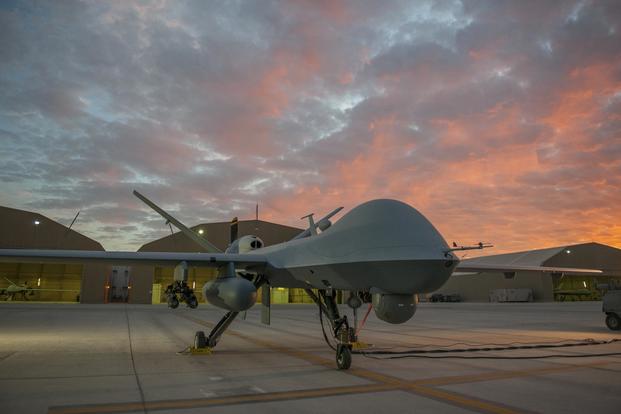General Atomics-Aeronautical Systems has received a $39.6 million contract to provide MQ-9 Reapers to a Marine advisory unit in Afghanistan for air overwatch and reconnaissance, according to Pentagon announcements.
The Reapers, the first Group 5 unmanned aerial systems to be assigned exclusively to a Marine unit, may arrive in theater very soon, documents show. Group 5 is the largest class of UAS and includes platforms such as the RQ-4 Global Hawk and MQ-4C Triton.
According to the contract announcement, General Atomics contractors, not Marines, will operate the systems in Afghanistan. The award was first reported Wednesday by The Drive.
While Task Force Southwest, a small contingent of several hundred Marines on the ground in Helmand Province, Afghanistan is primarily charged with providing advice and assistance to Afghan National Security Forces in their fight with local Taliban elements, a significant portion of the unit's work involves coordinating strikes on enemy targets using UAS.
When Military.com visited the unit in December and toured its operations center, Marines coordinated three deadly strikes in a single morning, using small ScanEagle drones to identify targets and Air Force F-16 Fighting Falcons to drop ordnance to take them out.
"This is what we do on a daily basis, is provide overwatch," Capt. Brian Hubert, battle captain for Task Force Southwest, told Military.com at the time. "And then also, there's a little bit of advising, because we will call them and say, 'Hey, think about doing this, or we see you doing this, that looks good, you should go here.' We're trying to get them to the point where eventually, with their Afghan Air Force, they can do all themselves."
Having Reapers, which can fly at top speeds of 300 miles per hour and can carry more than 3,700 pounds of ordnance, including Hellfire missiles, GBU-12 Paveway II bombs and GBU-38 Joint Direct Attack Munitions, would allow the Marine task force to operate more independently rather than depending on other units for deadly force from the air.
"Task Force Southwest currently uses Group 5 [Unmanned Aerial Systems] extensively when they are provided from available assets in theater," Brig. Gen. Benjamin Watson, commander of the task force, told Military.com in January. "An organic Group 5 UAS capability will give us more capacity to assist our Afghan partners as they conduct continuous offensive operations against the enemy in Helmand province."
As an additional benefit, having the Reapers available may help the Marines prepare to receive and operate their own Group 5 drone, the MUX, which is now in the requirements phase.
That system, which will be designed to take off vertically from a ship and provide surveillance and network capabilities from the air, is planned to reach initial operational capability around 2027.
The contract award notice for the Reapers does not specify when the systems will arrive in Afghanistan. Earlier solicitations called for the capability by March of this year. But all work on the contract is set to be completed by November, the announcement states.
-- Hope Hodge Seck can be reached at hope.seck@military.com. Follow her on Twitter at @HopeSeck.










